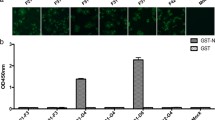Summary
Purified Japanese encephalitis (JE) virus was solubilized under reducing condition by using 2-merceptoethanol (2 ME) or nonreducing condition without 2 ME and its structural proteins were separated by polyacrylamide gel electrophoresis in the presence of sodium dodecyl sulfate (SDS-PAGE), followed by the Western blotting using polyclonal and monoclonal antibodies against JE. The mobilities and reactivities against polyclonal anti-serum of V 3 (E) and V 2 (C) were reduced when virion was disrupted under reducing condition. The 54 K band corresponding to V 3 was treated with cyanogen bromide (CNBr) and analyzed by the second SDS-PAGE and Western blotting. By Coomassie Blue staining multiple bands of molecular weight ranging from 54 K to 8 K daltons were revealed for CNBr-treated V 3. For the specimens disrupted under reducing condition, uncleaved 54 K and cleaved 8 K, 14 K, 45 K, and 48 K bands were reactive by one of the JE and Murray Valley encephalitis (MVE) crossreactive monoclonal antibodies (NARMA 16), while other monoclones did not show any reactivity. The uncleaved V 3 prepared under nonreducing condition was reactive with several monoclones to almost similar levels. After CNBr treatment, the antigenic epitope(s) for a flavivirus-common monoclone (NARMA 24) and those for NARMA 16 appeared to locate on different fragments, while the epitopes for other monoclones lost their antigenicities. These results indicate the importance of disulfide bond and highly organized structure to maintain some of the epitopes on V 3.
Similar content being viewed by others
References
Burnettte WN (1981) “Western blotting”: electrophoretic transfer of proteins from sodium dodecyl sulphate-polyacrylamide gels to unmodified nitrocellulose and radiographic detection with antibody and radioiodinated protein A. Anal Biochem 112: 195–203
Dietzschold B, Wiktor TJ, Macfarlan R, Varrinchio A (1982) Antigenic structures of rabies virus glycoprotein: ordering and immunological characterization of the large CNBr cleavage fragments. J Virol 44: 595–602
Durbin RK, Stollar V (1984) A mutant of Sindbis virus with a host-dependent defect in maturation associated with hyperglycosylation of E 2. Virology 135: 331–344
Eagle H (1959) Amino acid metabolism in mammalian cell cultures. Science 130: 432–437
Friedman RM (1968) Structural and nonstructural proteins of an arbovirus. J Virol 2: 1076–1080
Hasegawa H (1982) Characterization of monoclonal antibodies against Japanese encephalitis virus. J Jpn Assoc Infect Dis 56: 855–866 (in Japanese)
Hori H, Morita K, Igarashi A, Yoshida I, Takagi M (1986) Oligonucleotide fingerprint analysis on Japanese encephalitis virus strains isolated in Japan and Thailand with reference to effect of passage histories on the fingerprints. Acta Virol 30: 353–359
Igarashi A (1978) Isolation of a Singh'sAedes albopictus cell clone sensitive to dengue and chikungunya viruses. J Gen Virol 40: 531–544
Kimura-Kurada J, Yasui K (1983) Topographical analysis of antigenic determinants on envelope glycoprotein V 3 (E) of Japanese encephalitis virus, using monoclonal antibodies. J Virol 45: 124–132
Kobayashi Y, Hasegawa H, Tamai T, Kusaba T (1984) Antigenic analysis of Japanese encephalitis virus using monoclonal antibodies. Infect Immun 44: 117–123
Laemmli UK (1970) Cleavage of structural protein during the assembly of the head of bacteriophage T 4. Nature 227: 680–685
Naser WL, Miltenburger HG (1983) Rapid baculovirus detection, identification and serological classification by Western blotting—ELISA using monoclonal antibodies. J Gen Virol 64: 639–647
Nikoden V, Fresco JR (1979) Protein fingerprinting by SDS-gel electrophoresis after partial fragmentation with CNBr. Anal Biochem 97: 382–386
Shapiro D, Brandt WE, Cardiff RD, Russell PK (1979) The proteins of Japanese encephalitis virus. Virology 44: 108–124
Srivastava AK, Igarashi A (1985) Comparison of Japanese encephalitis virus isolates from Japan and Thailand by peptide mapping. Trop Med 27: 269–275
Studier FM (1973) Analysis of bacteriophage T 7 early RNAs and proteins on slab gels. J Mol Biol 79: 237–248
Takegami T, Miyamoto H, Nakamura H, Yasui K (1982) Differences in biological activity of the V 3 envelope proteins of two Japanese encephalitis virus strains. Acta Virol 26: 321–327
Trent DW, Qureshi AA (1971) Structural and nonstructural proteins of Saint Louis encephalitis virus. J Virol 7: 379–388
Trent DW, Harvey CL, Qureshi A, Le Stourgeon D (1976) Solid-phase radioimmunoassay for antibodies to flavivirus structural and nonstructural proteins. Infect Immun 13: 1325–1333
Ward WC, Dopheide TAA (1979) A Hong Kong Influenza hemagglutinin light chain: amino acid sequence of cyanogen bromide fragment CN 2. Virology 95: 107–118
Author information
Authors and Affiliations
Rights and permissions
About this article
Cite this article
Srivastava, A.K., Aira, Y., Mori, C. et al. Antigenicity of Japanese encephalitis virus envelope glycoprotein V 3 (E) and its cyanogen bromide cleaved fragments examined by monoclonal antibodies and Western blotting. Archives of Virology 96, 97–107 (1987). https://doi.org/10.1007/BF01310993
Received:
Accepted:
Issue Date:
DOI: https://doi.org/10.1007/BF01310993




